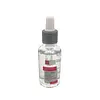What's inside
What's inside
 Key Ingredients
Key Ingredients

 Benefits
Benefits

 Concerns
Concerns

No concerns
 Ingredients Side-by-side
Ingredients Side-by-side

Water
Skin ConditioningGlycerin
HumectantPropylene Glycol
HumectantBeta-Glucan
Skin ConditioningLactic Acid
BufferingGlycolic Acid
BufferingPEG/PPG-17/6 Copolymer
SolventCeramide NP
Skin ConditioningTocopheryl Acetate
AntioxidantLactobionic Acid
BufferingPhenoxyethanol
PreservativeSqualane
EmollientCarbomer
Emulsion StabilisingTriethanolamine
BufferingXanthan Gum
EmulsifyingChlorphenesin
AntimicrobialButylene Glycol
Humectant1,2-Hexanediol
Skin ConditioningGluconolactone
Skin ConditioningBiosaccharide Gum-4
Skin ConditioningAlpha-Glucan Oligosaccharide
CleansingAlgin
MaskingPEG-40 Hydrogenated Castor Oil
EmulsifyingSodium Hyaluronate
HumectantHydrogenated Lecithin
EmulsifyingCholesterol
EmollientHydrolyzed Hyaluronic Acid
HumectantRetinol
Skin ConditioningIodopropynyl Butylcarbamate
PreservativeHydroxypropyl Cyclodextrin
MaskingAdenosine
Skin ConditioningWater, Glycerin, Propylene Glycol, Beta-Glucan, Lactic Acid, Glycolic Acid, PEG/PPG-17/6 Copolymer, Ceramide NP, Tocopheryl Acetate, Lactobionic Acid, Phenoxyethanol, Squalane, Carbomer, Triethanolamine, Xanthan Gum, Chlorphenesin, Butylene Glycol, 1,2-Hexanediol, Gluconolactone, Biosaccharide Gum-4, Alpha-Glucan Oligosaccharide, Algin, PEG-40 Hydrogenated Castor Oil, Sodium Hyaluronate, Hydrogenated Lecithin, Cholesterol, Hydrolyzed Hyaluronic Acid, Retinol, Iodopropynyl Butylcarbamate, Hydroxypropyl Cyclodextrin, Adenosine
Ingredients Explained
These ingredients are found in both products.
Ingredients higher up in an ingredient list are typically present in a larger amount.
Butylene Glycol (or BG) is used within cosmetic products for a few different reasons:
Overall, Butylene Glycol is a safe and well-rounded ingredient that works well with other ingredients.
Though this ingredient works well with most skin types, some people with sensitive skin may experience a reaction such as allergic rashes, closed comedones, or itchiness.
Learn more about Butylene GlycolGlycerin is already naturally found in your skin. It helps moisturize and protect your skin.
A study from 2016 found glycerin to be more effective as a humectant than AHAs and hyaluronic acid.
As a humectant, it helps the skin stay hydrated by pulling moisture to your skin. The low molecular weight of glycerin allows it to pull moisture into the deeper layers of your skin.
Hydrated skin improves your skin barrier; Your skin barrier helps protect against irritants and bacteria.
Glycerin has also been found to have antimicrobial and antiviral properties. Due to these properties, glycerin is often used in wound and burn treatments.
In cosmetics, glycerin is usually derived from plants such as soybean or palm. However, it can also be sourced from animals, such as tallow or animal fat.
This ingredient is organic, colorless, odorless, and non-toxic.
Glycerin is the name for this ingredient in American English. British English uses Glycerol/Glycerine.
Learn more about GlycerinPhenoxyethanol is a preservative that has germicide, antimicrobial, and aromatic properties. Studies show that phenoxyethanol can prevent microbial growth. By itself, it has a scent that is similar to that of a rose.
It's often used in formulations along with Caprylyl Glycol to preserve the shelf life of products.
Sodium Hyaluronate is hyaluronic acid's salt form. It is commonly derived from the sodium salt of hyaluronic acid.
Like hyaluronic acid, it is great at holding water and acts as a humectant. This makes it a great skin hydrating ingredient.
Sodium Hyaluronate is naturally occurring in our bodies and is mostly found in eye fluid and joints.
These are some other common types of Hyaluronic Acid:
Learn more about Sodium HyaluronateWater. It's the most common cosmetic ingredient of all. You'll usually see it at the top of ingredient lists, meaning that it makes up the largest part of the product.
So why is it so popular? Water most often acts as a solvent - this means that it helps dissolve other ingredients into the formulation.
You'll also recognize water as that liquid we all need to stay alive. If you see this, drink a glass of water. Stay hydrated!
Learn more about Water